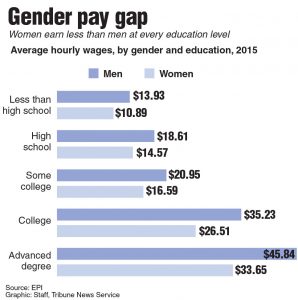Freedom, justice and equality epitomize power. Globally revered as an international superpower, the United States embodies these three concepts. However, an ongoing debate ensues among U.S. residents questioning if women are treated equal to men. According to the July 2014 Census, 162 million females live in the U.S., compared to 157 million males. As the majority, women play a large role in US politics, economics, government, and corporations; they seek higher educations, professions and paychecks. Society plays a role at defining women’s measure of equality to men.
Women Deserve More
Expectations define equality between men and women. Stereotypes of stay-at-home moms and kitchen-working women set expectations of women too low. These mislead people to underestimate a woman’s worth in the workplace and result in the pay gap and fewer executive positions for women, despite statistics that show women are earning more bachelor’s degrees and making more money in CEO positions than men.
Women face unequal pay in the workplace despite their equal qualifications to men. According to the Washington Post, in 2016 women earn 79 cents for every dollar a man earns. A Labor Department study, cited in The Wall Street Journal, reveals that women with a bachelor’s degree or in elite job positions get paid as little as 76 percent of their male counterparts.
As of 2015, young women have a higher likelihood of earning a college degree. According to TIME, 37.5 percent of women age 25 to 34 earned a bachelor’s degrees, passing the 29.5 percent of men in the same age group. TIME‘s statistics provide evidence that current and future generations of women display a greater number of college degrees in the workplace than men. The pay gap lessens to 79 percent of male coequals’ pay in women without college educations, but chances of raises among this group of women drops as well. The Wall Street Journal claims the lack of education in women without college degrees increases the ease in replacing workers and decreases their likelihood of moving up the pay scale.
Beyonce may have been wrong: there is a lack of evidence that many girls are given the chance to run the world. When women receive more education in a nation that swears by equality, the logical assumption is that they have the upper hand in management, executive positions, and other higher-level jobs. But the facts debunk logic: of the 52 percent of professional jobs held by women in the US, only 14.6 percent of women hold executive positions. The numbers of women in leadership positions decrease further with eight percent of women earning top pay and about five percent in Fortune 500 CEO positions. According to the Wall Street Journal, women’s pay percentages compared to men decreases as the amount of time out of college increases. As they gather more experience and move up in occupations, their pay lags behind them.
According to a Peterson Institute for International Economics study, published in the New York Times, of nearly 22,000 companies from 91 countries, increasing the percent of women from zero to 30 percent in a company would increase profitability by 15 percent. Data proves women increase profits in organizations internationally.
Many people dispute the existence of a pay gap or inequality whatsoever. People righteously question the facts published by many unreliable organizations on women’s inequality but mistake inaccurate facts as an incorrect argument. Reputable publications such as TIME call out the lack of accuracy the media provides on these issues. However, these publications do not debunk the fact that women receive less pay and higher-level positions than men. The internet’s reliability on numbers and facts depends on the source of information. When unreliable sources surface at the top of search engines, powerful and trustworthy voices argue over a mess of controversial statistics instead of deeply researching reliable data and advocating for a movement toward equality.
Women show the qualifications needed for taking on the same higher-level positions and pay rates as men. The people of the U.S. are responsible for ensuring such valuable members of society are treated equally.
Click here to read ‘From the right.’

